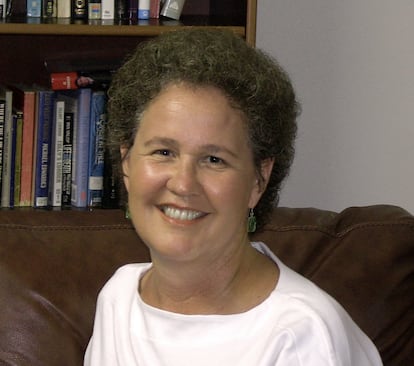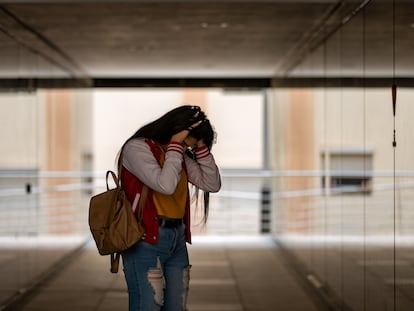Linda Darling-Hammond: ‘Kids need to be taught how to deal with phones, not just have them taken away’
The Stanford University teacher, who heads the California Board of Education, is one of the most influential voices in education policy in the United States


Linda Darling-Hammond, the president of the California Board of Education since 2019, has spent a lifetime speaking, writing, studying and teaching about education. A teacher at Stanford University and educational advisor during Barack Obama’s 2008 and Joe Biden’s 2020 presidential campaigns, she has written numerous books and articles on education policy and believes that teaching is currently at an inflection point. For the academic, who spoke with EL PAÍS via video call, the students of the new generations need less memorization and more support, exams where they can apply what they know and tools that help them learn wherever they are.
Question. In 2015, during a talk on the evolution of teaching that you gave at Stanford, you said that education must respond to the demands of the age it is in. What age are we in right now?
Answer. We are in an age of knowledge explosion, technology expansion, massive change in the world and global climate change. And of course, with AI becoming even more commonplace and with more and more automation, the jobs that people will have to do, the knowledge they’ll need to have, is going to be very, very different. One example I often give is that between 1999 and 2003, there was more new knowledge created in the world than in the entire history of the world preceding. And knowledge is now doubling faster every year. So the old idea that somehow there’d be a curriculum that students could learn for 12 years and then be all ready to go out in the world is completely blown apart.
Q. What should this “new” education be like?
A. Children and adults need to be able to continually learn, to be able to do that on their own because there’s going to be new knowledge all the time. To make sense of it, to combine information, to evaluate, to analyze, to synthesize, to apply. Second thing is that we’ve got these massive changes in the economy and in the climate and all those kinds of things that both require the use of technology for work, but also for learning. With increasingly frequent climate events affecting school attendance, school has to be not just when you’re in your seat; we need to get technology devices and connectivity to all kids so that when they can’t get to school, they can still be online with each other and their teacher and still learning.
Q. While this changes, access to higher education in many countries remains focused on common tests, such as the EBAU in Spain or the A-Levels in the UK.
A. During the pandemic, a lot of testing couldn’t occur because testing sites were not open. In the United States, we’ve had a test for many years called the Scholastic Aptitude Test (SAT) that got you into college. But 80% of colleges abandoned the SAT during the pandemic, and many of them either made it optional or said “we don’t care at all,” and they’re using other things to admit students to college.
Q. Such as?
A. There are things like the International Baccalaureate Program, which is in 125 countries around the world, where assessment is a combination of investigations and research papers and collaborative projects and so on. When you have completed that kind of program and done well on those assessments, which are much more applied, it is a good predictor of your ability to do work in college. In the U.S., there’s something called the Advanced Placement Program, which has been doing these kinds of tests and courses and testing in high schools, and now they’re adding projects to their courses and assessments.
Q. Are these types of evaluations what the educational system of the future should aspire to?
A. With the most productive assessments you can actually see what kids can do. If we’re going to have assessments, they need to become more authentic assessments. They need to become more performance-based and rely a lot less on memorization. We’ve had a big emphasis on memorization, which is very antiquated now. Maybe back in the day when people didn’t have books to go to, or Google, they had to memorize a lot of things, but that is not the mode of learning that is most useful right now. What we need to know is how to help young people learn to inquire and apply their knowledge in real life to solve real life problems.
Q. In the United States and other countries, parents can choose whether to enroll their children in school or educate them at home. What is your view on homeschooling?
A. Homeschooling is going up in the United States now, and I think it is because we have to change from the factory model schools that we inherited from 100 years ago, which are very regimented. They’re very bureaucratic, very top-down. They’re not designed to be highly individualized and to meet students where they are and to support them in what they need. I think homeschooling is in part a reaction, people saying: my kid is getting lost in that factory model, and I’ve got to do something else for them. We have fabulous teachers and principals who are working to make that model fit the demands of today, but we need to redesign the model.
Q. What kind of redesign?
A. For example, small schools, 300 or 400 students, not 2,000. Designed with a teaching team that wraps around a group of students, planning around the students and planning interdisciplinary instruction and having time to do that. With the students in advisory programs where they have a teacher for four years who stays with them and does social and emotional learning and checks up on how they’re doing academically and meets with the parents multiple times a year. In those settings, kids are thriving; in the factory model schools, many times they are not.
Q. In 2023 the last PISA report was published, and in a large number of countries the score decreased compared to previous years.
A. The pandemic was traumatic in many, many ways. It wasn’t just that the kids were out of physical schooling for a period of time. They were online. They were learning in different ways. But families were traumatized, children lost their parents and grandparents. There was a lot of economic disruption. So we’re in a period of time where, again, schools can’t function the way they used to. And there are two different impulses. Some people have been saying: let’s take advantage of what we’ve learned to do in the pandemic, the ways in which we learned to use technologies, the ways in which we began to change the learning. Other people are saying: let’s get back to normal. They’re trying to pull the schools back to being just the way they were in 2019, and that is not going to work. Doubling down on getting back to normal is making things worse.
Q. Is being at the top of the PISA report equal to having a better education system?
A. Well, it says something [about that country’s system]. The PISA assessments are better than some others in terms of being a little more forward looking. They’re trying to evaluate things like collaboration and problem solving and application of knowledge. They tell us something about the equality within a country, like how well do most students do? Of course, there are other things that are also happening that don’t have to do with the education system. If you have poverty and kids don’t have enough to eat and don’t have a place to live and so on, the education system cannot cure all of that. And if there are low PISA scores associated with those social conditions, that’s not the fault of the schools. When people look at these kinds of scores, they have to take it with a grain of salt and say, “Okay, what might we learn from this? What else would we have to ask to even understand what’s going on?”
Q. You mentioned that one of the current challenges is new technologies. In Spain, one of the main debates in this regard is whether or not mobile phones should be banned in schools.
A. Part of the pressure to ban the phones is that is two-fold; kids are on their phones and not paying attention. They’re surfing during class, but also on social media, which is so destructive for students. Frankly, I don’t think banning the phone does reduce the amount of distraction that they might get. Kids need to be taught how to deal with these things, not just have them taken away. There’s some utility in having some limits on the use of phones at some point in time in school, but also maybe not ignoring them entirely and helping kids learn how to use them. We have to deal with that, rather than just saying, “Oh, let’s stamp it down and ignore it.”
Q. What is your vision for the ideal education in the next 15 years?
A. One in which the schools are more personalized, with integrated support for students. Focused on social, emotional and academic development of the sort that will allow students to be empowered learners who can use and access knowledge and apply it in all of these challenging situations that are going to be part of their world.
Sign up for our weekly newsletter to get more English-language news coverage from EL PAÍS USA Edition
Tu suscripción se está usando en otro dispositivo
¿Quieres añadir otro usuario a tu suscripción?
Si continúas leyendo en este dispositivo, no se podrá leer en el otro.
FlechaTu suscripción se está usando en otro dispositivo y solo puedes acceder a EL PAÍS desde un dispositivo a la vez.
Si quieres compartir tu cuenta, cambia tu suscripción a la modalidad Premium, así podrás añadir otro usuario. Cada uno accederá con su propia cuenta de email, lo que os permitirá personalizar vuestra experiencia en EL PAÍS.
¿Tienes una suscripción de empresa? Accede aquí para contratar más cuentas.
En el caso de no saber quién está usando tu cuenta, te recomendamos cambiar tu contraseña aquí.
Si decides continuar compartiendo tu cuenta, este mensaje se mostrará en tu dispositivo y en el de la otra persona que está usando tu cuenta de forma indefinida, afectando a tu experiencia de lectura. Puedes consultar aquí los términos y condiciones de la suscripción digital.
More information
Archived In
Últimas noticias
Welcome to the post-religion era: The idea of Christianity as the absolute truth has become obsolete
‘I thought you would like it’: The risky sexual practice popularized by TV shows and TikTok
The digitalization of tourism: ‘They promise experiences and gave us the worst possible one’
Mexican peso defies uncertainty with forecasts of a new period of stability in 2026
Most viewed
- Sinaloa Cartel war is taking its toll on Los Chapitos
- Reinhard Genzel, Nobel laureate in physics: ‘One-minute videos will never give you the truth’
- Oona Chaplin: ‘I told James Cameron that I was living in a treehouse and starting a permaculture project with a friend’
- Why the price of coffee has skyrocketed: from Brazilian plantations to specialty coffee houses
- Silver prices are going crazy: This is what’s fueling the rally










































